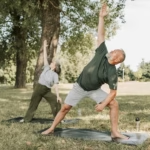Virtual physiotherapy is transforming how expert MSK care is delivered here at The Heal Hut, we believe high-quality physiotherapy should be accessible, flexible, and effective—no matter where you are. While virtual care may be new to some, it’s backed by a growing body of rigorous, peer-reviewed research. Here’s what the latest evidence says about the safety, efficacy, and benefits of remote physiotherapy.
🧠 What the Evidence Shows
✅ Virtual Care is as Effective as In-Person Physiotherapy
- The REFORM Study (2022): A large randomised controlled trial involving 210 patients with musculoskeletal conditions found no difference in clinical outcomes between those treated via video consultation and those seen in person. Patients had equivalent functional gains at 6 and 26 weeks.
✅ Virtual Physiotherapy for Osteoarthritis is Safe and Effective
- Knee OA Trial (2020): A 14-week telerehabilitation programme showed equivalent improvements in pain, function, and patient satisfaction compared to traditional face-to-face care.
✅ Older Adults Benefit Too
- Systematic Review (2021): A meta-analysis of studies in older adults found non-inferior outcomes in key mobility tests (6-minute walk test, Timed Up & Go) when care was delivered remotely.
✅ Tele-rehab is Widely Effective Across MSK Conditions
- Systematic Reviews (2021-2023): Multiple reviews concluded that telehealth can produce comparable outcomes in pain, function, and quality of life to in-person therapy, with added convenience and cost benefits.
✅ Patients Like It
- Satisfaction rates in many studies are over 90%, with users reporting high levels of comfort, convenience, and confidence in their care.
✅ It’s Cost-Effective
- Several studies confirm that remote care can reduce healthcare costs while maintaining (or improving) outcomes, especially when delivered by experienced clinicians.
✔️️ What This Means for You
Virtual physiotherapy isn’t a second-best option—it’s a clinically validated, safe, and accessible model for most musculoskeletal conditions. Our experienced clinicians use video consultation, personalised exercise plans, and digital tools like WriteUpp and PhysioTracker to ensure your recovery is effective and supported.
For those who require hands-on care, our team will always guide you toward appropriate in-person services. But for many, virtual care offers the perfect balance of expert support, flexibility, and results.
To find out what TheHealHut can offer you click here.
In addition to read more evidence on virtual care from the NHS Long Term Plan.
🔗 References
Seron P, et al. (2021). Economic impact of telehealth interventions for musculoskeletal conditions. BMC Health Services Research, 21(1), 578
Cottrell MA, et al. (2022). Efficacy of telerehabilitation for musculoskeletal conditions: REFORM RCT. Journal of Physiotherapy, 68(4), 270-278.
Ferreira ML, et al. (2020). Comparing telerehabilitation and face-to-face rehabilitation for knee osteoarthritis: a randomised controlled trial. Osteoarthritis and Cartilage, 28(7), 910-918.
Taito S, et al. (2021). Effect of telerehabilitation on physical performance in older adults: a systematic review and meta-analysis. Archives of Gerontology and Geriatrics, 92, 104267.
Turolla A, et al. (2021). Telerehabilitation in physical therapy: A systematic review. Journal of Telemedicine and Telecare, 27(8), 452-471.
Hwang R, et al. (2020). Patient satisfaction with telehealth physiotherapy. Physiotherapy Theory and Practice, 36(6), 617-625.
Grona SL, et al. (2018). Use of video-based consultations in musculoskeletal physiotherapy care: A literature review. Physiotherapy Canada, 70(2), 157-165.


